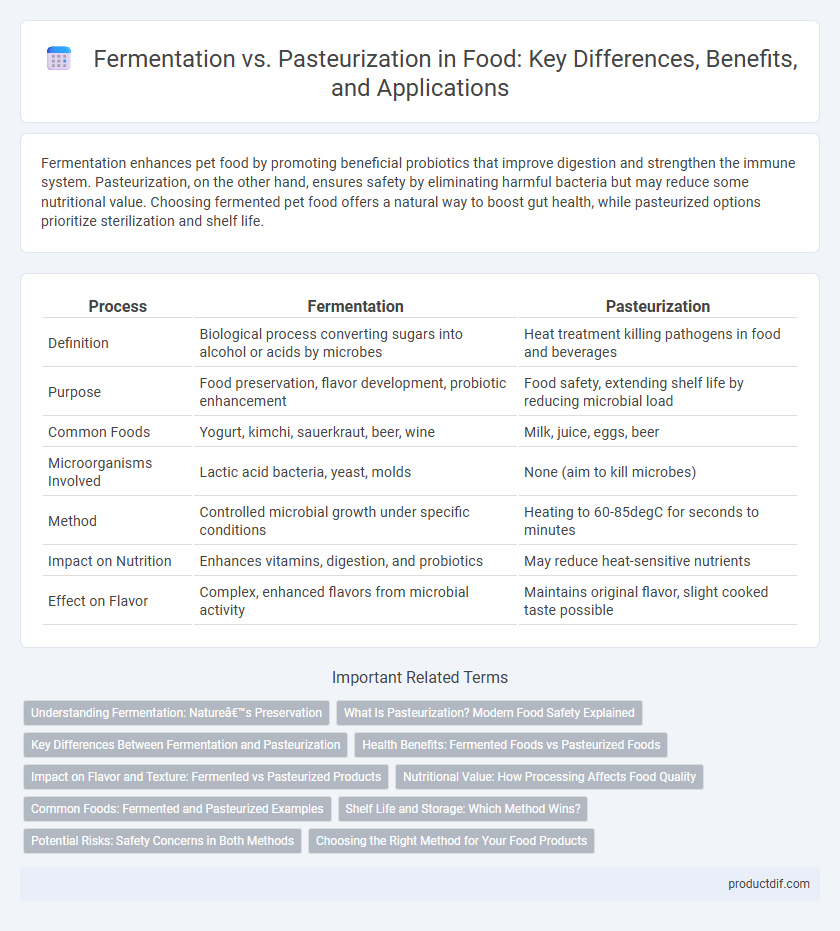Fermentation enhances pet food by promoting beneficial probiotics that improve digestion and strengthen the immune system. Pasteurization, on the other hand, ensures safety by eliminating harmful bacteria but may reduce some nutritional value. Choosing fermented pet food offers a natural way to boost gut health, while pasteurized options prioritize sterilization and shelf life.
Table of Comparison
| Process | Fermentation | Pasteurization |
|---|---|---|
| Definition | Biological process converting sugars into alcohol or acids by microbes | Heat treatment killing pathogens in food and beverages |
| Purpose | Food preservation, flavor development, probiotic enhancement | Food safety, extending shelf life by reducing microbial load |
| Common Foods | Yogurt, kimchi, sauerkraut, beer, wine | Milk, juice, eggs, beer |
| Microorganisms Involved | Lactic acid bacteria, yeast, molds | None (aim to kill microbes) |
| Method | Controlled microbial growth under specific conditions | Heating to 60-85degC for seconds to minutes |
| Impact on Nutrition | Enhances vitamins, digestion, and probiotics | May reduce heat-sensitive nutrients |
| Effect on Flavor | Complex, enhanced flavors from microbial activity | Maintains original flavor, slight cooked taste possible |
Understanding Fermentation: Nature’s Preservation
Fermentation leverages beneficial microorganisms like bacteria and yeast to naturally preserve food by converting sugars into acids, alcohol, or gases, enhancing flavor and nutritional value. This biological process increases shelf life while promoting probiotic benefits that support gut health. Unlike pasteurization, which uses heat to kill pathogens, fermentation relies on controlled microbial activity to maintain food safety and quality.
What Is Pasteurization? Modern Food Safety Explained
Pasteurization is a heat treatment process that kills harmful microorganisms in food and beverages, enhancing safety and extending shelf life without significantly affecting flavor or nutritional value. Originating from Louis Pasteur's 19th-century research, it is widely applied to milk, juice, and canned foods to prevent spoilage and foodborne illnesses. Modern food safety protocols use precise temperature and time controls, such as heating milk to 72degC for 15 seconds (high-temperature short-time pasteurization), to ensure microbial destruction while maintaining quality.
Key Differences Between Fermentation and Pasteurization
Fermentation is a natural biochemical process where microorganisms like bacteria and yeast convert sugars into acids, gases, or alcohol, preserving food and enhancing flavors. Pasteurization involves heating food to a specific temperature to kill harmful pathogens and extend shelf life without altering flavor significantly. Fermentation promotes beneficial probiotics for gut health, while pasteurization prioritizes food safety by eliminating microbial threats.
Health Benefits: Fermented Foods vs Pasteurized Foods
Fermented foods contain beneficial probiotics that enhance gut health, improve digestion, and boost the immune system by promoting a balanced microbiome. Pasteurized foods, while safer by eliminating harmful pathogens, lack these live microorganisms and thus do not provide the same probiotic benefits. Consuming fermented foods regularly supports nutrient absorption and may reduce inflammation, offering advantages that pasteurized foods do not typically deliver.
Impact on Flavor and Texture: Fermented vs Pasteurized Products
Fermentation enhances flavor complexity and texture by promoting natural enzymatic activity and beneficial microbial growth, resulting in tangy, rich, and often effervescent products like yogurt and kimchi. Pasteurization, designed primarily for safety and shelf life extension, can diminish flavor nuances and produce a smoother, more uniform texture as heat treatment may denature proteins and reduce microbial diversity. Fermented foods maintain distinct sensory profiles linked to fermentation metabolites, whereas pasteurized items often offer milder, more consistent tastes and textures due to thermal processing.
Nutritional Value: How Processing Affects Food Quality
Fermentation enhances nutritional value by increasing bioavailability of vitamins, producing beneficial probiotics, and breaking down anti-nutrients that inhibit mineral absorption. Pasteurization, while ensuring food safety by eliminating harmful pathogens, can reduce heat-sensitive nutrients like vitamin C and some B vitamins. Choosing fermentation preserves and often boosts nutritional quality, whereas pasteurization prioritizes safety with some nutrient loss.
Common Foods: Fermented and Pasteurized Examples
Yogurt and kimchi are popular fermented foods rich in probiotics, enhancing gut health and digestion. Milk and fruit juices are commonly pasteurized to eliminate harmful bacteria and extend shelf life without altering taste significantly. Cheese undergoes both fermentation and pasteurization processes, combining benefits of probiotic content and food safety.
Shelf Life and Storage: Which Method Wins?
Fermentation enhances shelf life by promoting beneficial microbial activity that naturally preserves food, often allowing storage at room temperature without spoilage. Pasteurization extends shelf life by heat-treating products to eliminate pathogens and reduce microbial load, requiring refrigerated storage to maintain safety and quality. For long-term, ambient storage, fermentation offers superior preservation, while pasteurization is optimal for refrigerated products with controlled shelf life.
Potential Risks: Safety Concerns in Both Methods
Fermentation relies on beneficial microbes to preserve food but poses risks of harmful bacteria or mold contamination if not properly controlled, potentially causing foodborne illnesses. Pasteurization effectively kills most pathogens through heat treatment, yet improper temperature or time settings can lead to survival of resilient bacteria, risking spoilage or health hazards. Both methods require strict monitoring and hygiene to ensure safety and prevent toxic byproducts or microbial resistance.
Choosing the Right Method for Your Food Products
Fermentation enhances food products by promoting beneficial probiotics and natural preservation, ideal for yogurts, sauerkraut, and kimchi rich in live cultures. Pasteurization effectively eliminates harmful bacteria through controlled heat treatment, ensuring safety in dairy, juices, and liquid eggs without significantly altering taste. Selecting the right method depends on desired shelf life, nutritional retention, and flavor profile, with fermentation favoring probiotic benefits and pasteurization prioritizing microbial safety.
Fermentation vs Pasteurization Infographic

 productdif.com
productdif.com